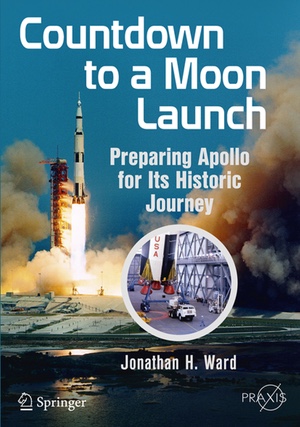Review: Countdown to a Moon Launchby Jeff Foust
|
| Schedules were worked out on a blackboard, and at the end of the day “a photographer came in to photograph the blackboard. The photo was converted into the next day’s schedule.” |
Jonathan Ward’s book Countdown to a Moon Launch offers an answer to that question. A companion to Rocket Ranch, his book about the facilities at the Kennedy Space Center (see “Review: Rocket Ranch”, The Space Review, September 21, 2015), this book examines the intricate processes involved with launching a Saturn V. Ward examines the preparations for one particular mission—Apollo 11—on a week-by-week, then day-by-day and hour-by-hour, as the managers, engineers, and other workers got the launch vehicle and spacecraft ready for launch.
It might, at first glance, seem a bit of a stretch to turn launch processing for a mission into an entire book. However, as he did in Rocket Ranch, Ward mixes detailed technical information about launch preparations with anecdotes and other insights from the people who worked there. And, while the book primarily follows the preparations for Apollo 11, Ward includes events from other missions as well, particularly in cases where things did not go according to plan, as Apollo 11 had few major issues leading up to launch.
One area of interest in the book is how planning and scheduling for each mission was carried out. “The magnitude of the challenge is almost impossible to conceive,” Ward writes, particularly given the communications technologies of the day. While we take for granted project management software, email, and intranets to develop and disseminate plans, those earlier efforts were quite different: schedules were worked out on a blackboard, and at the end of the day “a photographer came in to photograph the blackboard. The photo was converted into the next day’s schedule.” Later, planned advanced to magnetic tags on metal boards.
The book also includes some interesting stories about the work preparing the Apollo 11 and other missions for launch not widely known. In one case, shortly after the third stage of the Saturn V that would launch Apollo 11 arrived at KSC, workers found a note in a restroom: “I have fixed the vehicle, and you won’t find it in time.” Fearing sabotage, the FBI was called in to investigate. The note, it turned out, was left by someone who wanted to have “a little fun” after a three-martini lunch. In another case, the Apollo 11 launch was nearly postponed after finding a suspected bad solder joint in a Saturn V electronics box. The delay was avoided after engineers checked the joint and decided—correctly—that it was good.
So are there lessons from Countdown to a Moon Launch for NASA as it plans to resume human missions beyond Earth orbit in the next decade? Not, to be certain, in some of the management approaches: it seems unlikely, in the second decade of the 21st century, NASA will revert to blackboards to schedule the workflow of launch preparations. But the planning, teamwork, and flexibility to cope with problems are all attributes as useful in the 2010s as they were in the 1960s.
